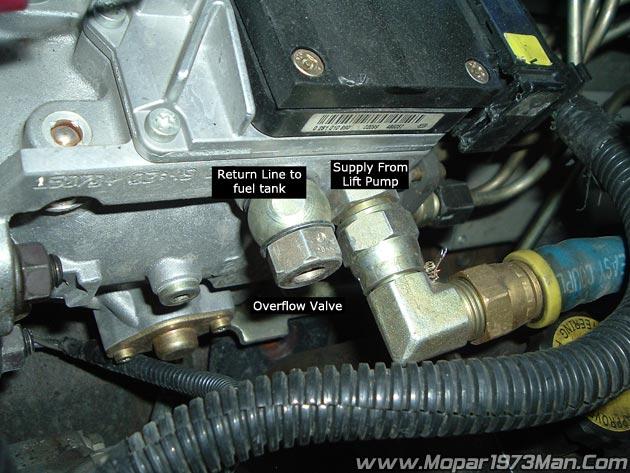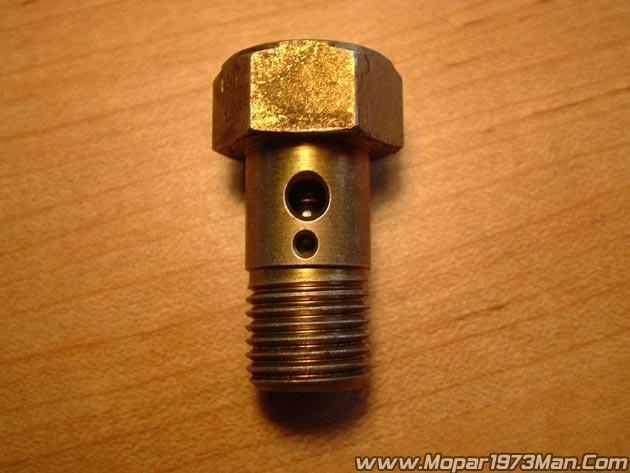Bosch VP44 Injection Pump Overflow Valve

Overflow Valve Description
The overflow valve is located on the side of the Bosch VP44 injection pump. It is also used to connect the fuel return line (banjo fitting) to the Bosch VP44 injection pump for your Cummins powered Dodge truck.
Overflow Valve Operation
Fuel volume from the fuel transfer (lift) pump will always provide more fuel than the fuel injection pump requires. The overflow valve (a check valve) is used to route excess fuel through the fuel return line and back to the fuel tank. Approximately 70% of supplied fuel is returned to the fuel tank. The valve opens at approximately 97 kPa (14 psi). If the check valve within the assembly is sticking open, fuel drainage of the Bosch VP44 injection pump could cause hard starting. If a Diagnostic Trouble Code (DTC) has been stored for “P0168 decreased engine performance due to high injection pump fuel temperature”, the overflow valve may be stuck in closed position.
Overflow Valve Diagnosis And Testing
A rubber tipped blow gun with regulated air line pressure is needed for this test.
1. Clean area around overflow valve and fuel return line at Bosch VP44 injection pump before removal.
2. Remove overflow valve from Bosch VP44 injection pump and banjo fitting.
3. Discard old sealing gaskets.
4. Set regulated air pressure to approximately 97kPa (14–16 psi).
5. Using blow gun, apply pressure to overflow valve inlet end ( the end that goes into Bosch VP44 injection pump).
6. The internal check valve should release, and air should pass through overflow valve at 97 kPa (14–16 psi). If not, replace overflow valve.
7. Reduce regulated air pressure to 10 psi and observe overflow valve. Overflow valve should stay shut. If not, replace overflow valve.
8. Install new sealing gaskets to overflow valve.
9. Install overflow valve through banjo fitting and into Bosch VP44 injection pump.
10. Tighten to 30 N·m (24 ft. lbs.) torque.
Overflow Valve Removal
The overflow valve (pressure relief valve) is located at the outside of fuel injection pump. It connects the fuel return line (banjo fitting) to the pump. The overflow valve has no internally serviceable parts and must be replaced as an assembly. Two sealing gaskets are used. One gasket is located between pump and banjo fitting. The other is located between the banjo fitting and end of the valve.
1. Clean area around overflow valve and fuel return line at injection pump before removal.
2. Remove valve from pump and banjo fitting.
3. Discard old sealing gaskets.
Overflow Valve Installation
The overflow valve (pressure relief valve) is located at the outside of fuel injection pump. It connects the fuel return line (banjo fitting) to the pump. The valve has no internally serviceable parts and must be replaced as an assembly. Two sealing gaskets are used. One gasket is located between pump and banjo fitting. The other is located between the banjo fitting and end of the valve.
1. Install new sealing gaskets to valve.
2. Install valve through banjo fitting and into the pump.
3. Tighten to 30 N·m (24 ft. lbs.) torque.
Few notes...

Here is a close up of the bleed hole in the overflow valve. This picture is magnified X10 so you can even see the tiny hole used to bleed air from the system.
There is a lot of controversy about the operation of the overflow valve on a Bosch VP44 injection pump Cummins selected. From my personal opinion that the overflow valve is the last check valve to hold the pressure up to 14 PSI for the injection pump. As for the bleed hole in the side that hole is so small, it can't possibly create enough flow to aid in cooling the Bosch VP44 injection pump unless the overflow valve is opened which listed above requires 14 PSI to be open.


